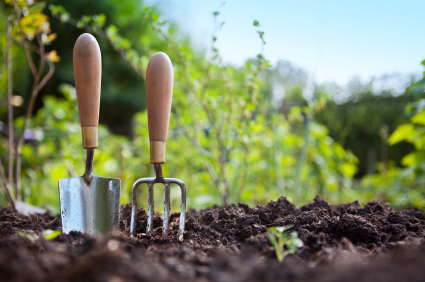Spring means that the garden centers are packed with people, and car trunks are packed with plants. Everybody has dirt on their knees, dirt under their nails, and are excited about gardening. To make certain that this excitement yields positive results, let’s discuss the basics of spring planting.
Installing new plants and having them grow successfully is not difficult, nor is it as complicated as some would have you think. Is it as easy as just digging a hole and setting the plant in? Yes, it certainly can be.
Let’s start with B&B plants. B&B is short for balled in burlap. Closely examine the ball on the plant that you have purchased. Did the diggers wrap twine around the ball to hold the plant secure? If they did, you should at least cut the twine and lay it in the bottom of the hole, or remove it completely. Pay close attention around the stem of the plant where it emerges from the root ball, as diggers often wrap the twine around the stem several times as they tie the ball. This is extremely important because if the string is nylon, it will not rot and will girdle and kill the plant two or three years from now.
When B&B plants are stored in the nursery for extended periods of time it becomes necessary to re-burlap them if the bottom starts to rot before the plants are sold. If the plant that you buy has been re-burlaped it is possible that there could be nylon stings between the two layers of burlap, check the stem carefully. As long as the nylon string is removed from around the stem of the plant, it is actually harmless around the rest of the ball, and you do not have to remove it.
Is the root ball wrapped in genuine burlap, or imitation burlap made of a non-biodegradable plastic material?
Genuine burlap will rot quickly underground and does not have to be disturbed before planting. If you’re not sure or suspect a poly type burlap, you don’t have to remove it completely, but should loosen it around the stem of the plant and cut some vertical slices around the circumference of the ball.
Now here’s the critical part. What kind of soil are you planting in?
If your soil is heavy clay, I highly suggest that your raise the planting bed at least 8” with good rich topsoil. If you can’t do that for some reason, install the plant so that at least 2” or more of the root ball is above the existing grade and mound the soil over the root ball. Keep in mind that plants installed this way could dry out over the summer, but planting them flush with the ground in heavy clay can mean that the roots will be too wet at other times of the year.
The “experts” suggest that when planting in clay soil you dig the hole wider and deeper than the root ball and fill around and under the plant with loose organic material. That sounds like a really great idea doesn’t it? Some of these experts also recommend that you dig the hole extra deep and put a few inches of gravel in the bottom for drainage. Where do you suppose they think this water is going to “drain” to?
Keep in mind that most B&B plants are grown in well drained soil. That means that the soil in the root ball is porous and water can easily pass through. Now imagine if you will, a root ball about 15” in diameter, setting in a hole 30” diameter. All around and under that root ball is loose organic matter. Inside of that root ball is porous soil. Now along comes Mother Nature with a torrential downpour. There is water everywhere, and it is not going to soak into that hard packed clay soil, so it is just flowing across the top of the ground searching for the lowest point.
When it reaches our newly planted tree surrounded by loose organic matter, it is going to seep in until the planting hole is completely full of water. (Remember my article on getting rid of standing water and the French drain system?) By using this planting technique we have actually created a French drain around our poor little plant that cannot tolerate its roots being without oxygen for long periods of time. Because the bottom of this hole is clay, even though we’ve added gravel for drainage, there is nowhere for the water to go, and this plant is going to suffer and likely die.
If you cannot raise the planting bed with topsoil, and are planting in clay soil, I recommend that you install the root ball at least 2” above grade and backfill around the ball with the soil that you removed when you dug the hole. Backfilling with the clay soil that you removed is actually like building a dam to keep excess water from permeating the root ball of your newly planted tree. The plant is not going to thrive in this poor soil, but at least it will have a chance to survive.
Once again, raising the bed with good rich topsoil is the best thing you can do to keep your plants healthy and happy.
No matter what kind of soil you have, be careful not to install your plants too deep. They should never be planted any deeper than they were grown in the nursery. Planting too deep is a common problem, and thousands of plants are killed each year by gardeners who just don’t understand how critical planting depth is.
Visit http://www.freeplants.com for more articles by Michael J. McGroarty




